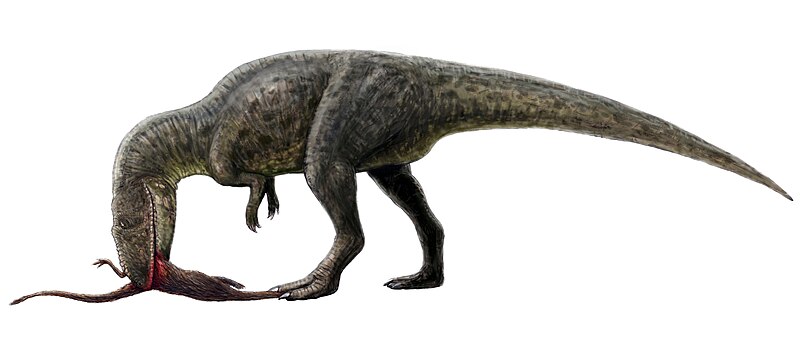Post by dinosauria101 on Jul 8, 2019 16:01:57 GMT 5
Archaeotherium mortoni
Archaeotherium (Greek, "Ancient Beast") is an extinct artiodactyl genus of the family Entelodontidae, endemic to North America during the Oligocene epoch (38—24.8 mya), existing for approximately 6 million years. Archaeotherium was about 1.2m tall at the shoulder and around 2m long and weighing around 270kg. It was a relative of javelinas and pigs. Evidence from the Wyoming Dinosaur Center suggests that Archaeotherium, like modern carnivores, kept caches of food when their hunting was unsuccessful. These bones were mainly those of Teleoceras. The largest (and type) species, A. mortoni was an aggressive, cow-sized apex predator. Rhino jaws and other mammal bones have been found with bite marks on them that match the large canines of A. mortoni. A fossil trackway in Toadstool Park depicts the path of a Subhyracodon walking forward, stopping to see an Archaeotherium approach, then breaking into a gallop with the entelodont chasing after it. In leaner times, it is suggested that Archaeotherium dug for roots and tubers, as with other pig-like mammals.

Shaochilong maortuensis
Shaochilong (meaning "shark toothed dragon") is a genus of carcharodontosaurid dinosaur from the mid Cretaceous (Turonian stage) Ulansuhai Formation of China (about 92 million years ago). The type species, S. maortuensis, was originally named Chilantaisaurus maortuensis, but was re-described and reclassified in 2009. The holotype, IVPP V2885.1-7, consisting of skull fragments, axis and six caudal vertebrae associated to a single individual is the only known specimen. This specimen was discovered in Outer Mongolia and described by Hu in 1964 as a species of Chilantaisaurus. Chure (2002) and Rauhut (2001) suggested that it did not belong to that genus, and was probably a primitive coelurosaur. However, a re-description by Brusatte and colleagues in 2009 found that it was in fact a carcharodontosaurid, the first recognized from Asia. The genus was originally informally named "Alashansaurus". IVPP V2885.1 was probably adult or nearly adult individual. Its length – based on the length of the maxillary tooth row – is estimated at 6 metres (20 ft). Estimated length of the femur is 61.5 cm, what suggests that whole animal weighted approximately 500 kilograms (1,100 lb).

Credit to Wikipedia
Archaeotherium (Greek, "Ancient Beast") is an extinct artiodactyl genus of the family Entelodontidae, endemic to North America during the Oligocene epoch (38—24.8 mya), existing for approximately 6 million years. Archaeotherium was about 1.2m tall at the shoulder and around 2m long and weighing around 270kg. It was a relative of javelinas and pigs. Evidence from the Wyoming Dinosaur Center suggests that Archaeotherium, like modern carnivores, kept caches of food when their hunting was unsuccessful. These bones were mainly those of Teleoceras. The largest (and type) species, A. mortoni was an aggressive, cow-sized apex predator. Rhino jaws and other mammal bones have been found with bite marks on them that match the large canines of A. mortoni. A fossil trackway in Toadstool Park depicts the path of a Subhyracodon walking forward, stopping to see an Archaeotherium approach, then breaking into a gallop with the entelodont chasing after it. In leaner times, it is suggested that Archaeotherium dug for roots and tubers, as with other pig-like mammals.

Shaochilong maortuensis
Shaochilong (meaning "shark toothed dragon") is a genus of carcharodontosaurid dinosaur from the mid Cretaceous (Turonian stage) Ulansuhai Formation of China (about 92 million years ago). The type species, S. maortuensis, was originally named Chilantaisaurus maortuensis, but was re-described and reclassified in 2009. The holotype, IVPP V2885.1-7, consisting of skull fragments, axis and six caudal vertebrae associated to a single individual is the only known specimen. This specimen was discovered in Outer Mongolia and described by Hu in 1964 as a species of Chilantaisaurus. Chure (2002) and Rauhut (2001) suggested that it did not belong to that genus, and was probably a primitive coelurosaur. However, a re-description by Brusatte and colleagues in 2009 found that it was in fact a carcharodontosaurid, the first recognized from Asia. The genus was originally informally named "Alashansaurus". IVPP V2885.1 was probably adult or nearly adult individual. Its length – based on the length of the maxillary tooth row – is estimated at 6 metres (20 ft). Estimated length of the femur is 61.5 cm, what suggests that whole animal weighted approximately 500 kilograms (1,100 lb).

Credit to Wikipedia


